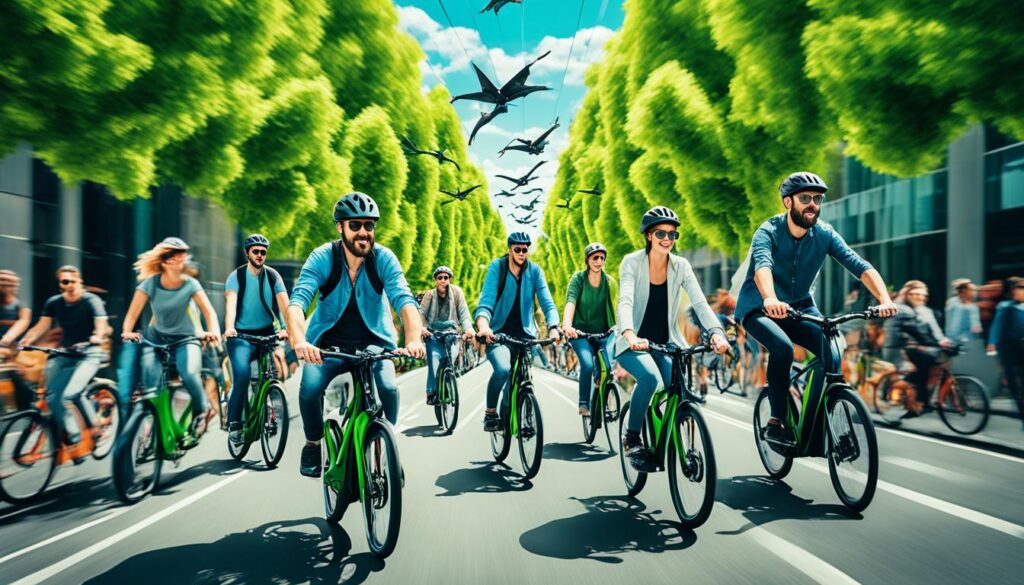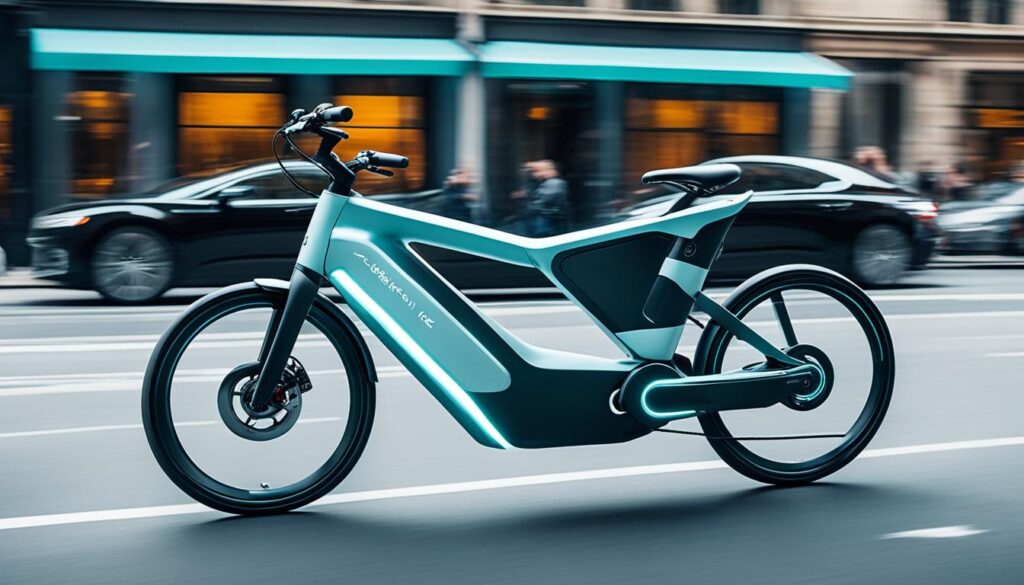Electric bikes are getting more popular as a green and handy way to travel. People thinking about buying one often wonder if they can stand rain or puddles. Knowing the difference between ‘waterproof’ and ‘water-resistant’ is crucial. While many reviews talk about an e-bike’s ability to handle moisture, it’s important to remember that no electric bike is totally waterproof. So, when you’re thinking of buying, knowing about an e-bike’s ability to resist water is key.
Key Takeaways
- E-bikes can safely operate in rain due to low voltage levels, typically below 60 volts.
- Consider the IP rating: E-bikes with IP66 or higher are recommended for riding in heavier rain conditions.
- Investing in quality rain gear and maintaining your bike chain can significantly improve wet weather performance.
- Brand name e-bikes often include better water-resistant seals, whereas budget options may be more susceptible to water damage.
- Essential post-ride care and warranty coverage inquiries play a pivotal role in e-bike maintenance and buyer confidence.
- Understanding that e-bikes are water-resistant, not waterproof, helps manage expectations regarding exposure to wet conditions.
- Taking proactive steps such as using fenders and wiping down the e-bike after use will extend the longevity of its components.
Understanding Electric Bike Water Resistance
When we talk about electric bikes, people often wonder how water-resistant they are. It’s important to know the difference between water-resistant and waterproof when looking at e-bikes. By understanding IP ratings and clearing up common wrong ideas, you get a better idea of how durable an electric bike is in different weather.
Defining Water-Resistant vs. Waterproof
Many mix up the terms water-resistant and waterproof, but they mean different things. A water-resistant e-bike can handle some moisture but might let water in over time or under certain conditions. On the other hand, a waterproof e-bike won’t get damaged if it’s submerged in water up to a certain depth for a certain time. These distinctions are key to how long your e-bike lasts and how it performs.
IP Ratings and What They Mean for Your E-Bike
The IP code stands for Ingress Protection, which tells you how well an e-bike resists water and solid objects. This rating system is by the International Electrotechnical Commission (IEC). The higher the second number in the IP code, the better the bike is protected against water. This is crucial for those who want their electric bike to last in wet conditions.
| First Digit (Solids) | Second Digit (Liquids) | Additional Protections |
|---|---|---|
| 0 – No protection | 0 – No protection | — |
| 6 – Dust-tight | 9 – High-temperature water jets | Various (F, H, M, S, W) |
| — | 7 – Immersion up to 1m (30 mins) | M – Motion during water test |
| — | 8 – Specified depth by manufacturer | F – Oil resistance |
| — | 69K – High-pressure, high-temperature wash-down (DIN 40050-9) | W – Weather conditions |
When choosing an electric bike, picking one with the right IP rating for your needs is wise. An IPX7 rating means it’s okay if it gets submerged briefly. IPX8 is for longer or deeper submersion. And IP69K offers strong protection but isn’t usually needed for e-bikes.
Misconceptions About Electric Bike Durability in Water
Even with IP ratings, some still get it wrong about how e-bikes handle water. It’s not true that all e-bikes are waterproof. If an e-bike doesn’t have a good IP rating, it might not work well if it gets wet. Also, not all parts of the bike might be protected against water. It’s important to know exactly how your e-bike is protected.
Making a smart choice about buying an e-bike means understanding water resistance, knowing about IP ratings, and not believing myths about e-bike durability. This way, we can enjoy our rides without worrying about the weather messing them up.
Riding Your Electric Bike in Different Wet Conditions
Riding electric bikes in wet conditions takes skill and caution. It also requires a well-prepared bike. Since e-bikes are built to resist water, riders can enjoy riding in the rain and puddles safely. But, following certain riding tips is key to protect the bike and keep the rider safe.
It’s smart not to ride on trails that are closed after rain. This helps protect the path and natural terrain from damage. When handling your e-bike, be careful; avoid hard braking or quick starts on slippery surfaces to reduce accident risks. Also, staying away from deep water helps keep the e-bike’s motor and battery safe.
Cleaning the e-bike after riding in wet conditions is crucial. It reduces wear and tear especially after going through gravel roads or muddy trails. Adding fenders can keep both the e-bike and rider clean by blocking mud and water splashes. Lowering tire pressure can also improve the e-bike’s grip on slick surfaces, giving the rider better control.
Getting an e-bike ready for rain involves more than just physical adjustments. There’s also a need to protect its electronic parts. The battery is designed to resist water, but it’s still vulnerable. High-pressure cleaning can damage less protected parts like the controller housing. The connections between e-bike parts, like the motor and display, are water-resistant. Yet, they must be assembled carefully to keep them safe from moisture.
Even though electric bikes use low voltage, which is safer in wet conditions, choosing one with a good Ingress Protection (IP) rating is smart. E-bikes with an IP code of 66 or above are suitable for wet weather riding. Avoiding heavy rain and storing your e-bike properly can prevent fast wear in humid conditions.
Seeing well in the rain, wearing the right gear, and keeping the bike clean are key for a good ride in wet weather. This includes taking care of important parts like the chain and brakes. Investing in a high-quality electric bike pays off. It lasts longer in rain compared to cheaper ones, which may need costly repairs due to bad sealing.
| Aspect | Consideration | Recommended Action |
|---|---|---|
| Traction & Control | Potential for slipping in wet conditions | Lower tire pressure; install fenders |
| Battery & Motor Safety | Risk from deep water exposure | Avoid deep puddles; ensure battery casing is intact |
| Post-Ride Care | Wear and tear after wet riding | Clean bike, paying attention to moving parts |
| Weatherproofing | Vulnerability of electronic components | Use e-bikes with appropriate IP code; avoid direct water pressure |
| Riding Gear | Personal comfort and safety | Use rain gear and lights for visibility |
| Long-term Storage | Corrosion from wet or humid conditions | Store in dry, weatherproof locations |
Critical E-Bike Components and Their Vulnerability to Water
As electric bikes become more popular, it’s crucial to know how water affects their parts. Some e-bike components are more at risk when exposed to water. This can impact how well and how long an electric bike works. Let’s explore which parts are most sensitive to water and look into an e-bike’s ability to resist it.
Which Parts Are Most at Risk?
The key parts of an e-bike, like the battery, motor, and control systems, are most exposed to water damage. Their quality and state determine how well the bike resists water. With the rising numbers of e-bike fires, focusing on these parts is vital. Especially the battery deserves extra attention.
The Anatomy of an E-Bike’s Water Resistance
When talking about water resistance, checking how e-bikes are built and sealed is important. Makers use special materials and methods to keep moisture out. This includes gaskets, seals, and protective coatings. The IP (Ingress Protection) ratings are also critical. They show how protected an e-bike is against water entering. But remember, no e-bike is totally safe from water damage.
| Statistic | 2017-2021 | 2021 | 2022 |
|---|---|---|---|
| Fires in New York City | – | 104 | 202 |
| Fires handled by London Fire Brigade | – | 70 | – |
| Electric bike fires in China | 10,000 (2013-2017) | – | – |
| Deaths in the U.S. related to e-mobility device fires | 6 | – | – |
| E-bikes imported to the U.S. | – | 880,000 | – |
Remembering incidents like the 5,000 battery packs recall shows how crucial safety standards are. It’s important for both users and makers to keep safety in mind. Paying attention to water resistance ratings helps make e-bike use safe and fun. With more e-bikes being brought into the U.S., addressing these safety concerns is urgent and vital for e-bike users.
Precautions and Protective Measures for Wet Weather Riding
Wet weather brings challenges for electric bike riders. It’s vital to know how to ride in the rain safely. TENWAYS, known for light models and focusing on safety, stresses the need for protective steps. The rise in e-bike accidents, especially noted in China’s reports, underlines this. Riders must take wet weather seriously to avoid accidents.
Investing in the Right Accessories
To improve wet weather rides, the right gear is a must. Fenders or mudguards keep water off the bike and the rider. It’s wise to use weatherproof covers for controls and cases for electronics against moisture. TENWAYS bikes, being light, offer more control in adverse weather. This helps in managing slippery paths and ensures safe getting on and off the bike.
Maintenance Post-Ride in Rainy Conditions
After riding in the rain, it’s crucial to maintain your bike properly. First, dry your bike well to prevent rust. Listen for any strange noises which might signal issues with the drivetrain or brakes. Regular checks after rides help avoid damage, keeping the bike running longer. TENWAYS guarantees their batteries with a strong warranty, highlighting the importance of maintenance. This care keeps your bike in good shape and makes e-biking safer for everyone.



